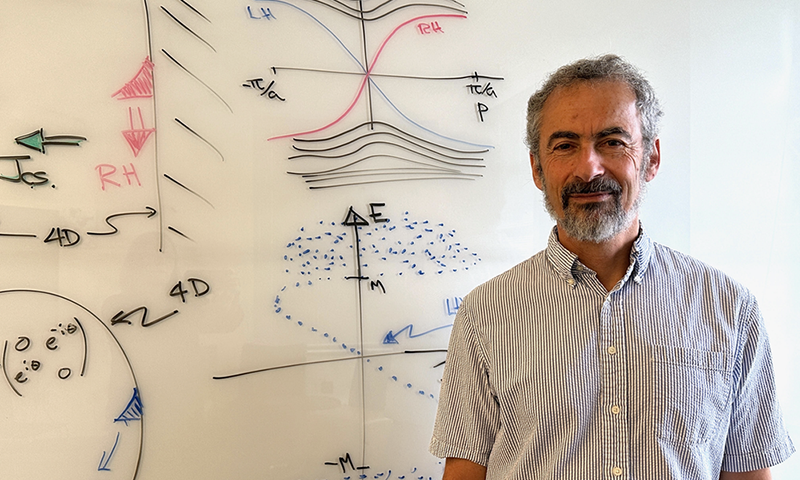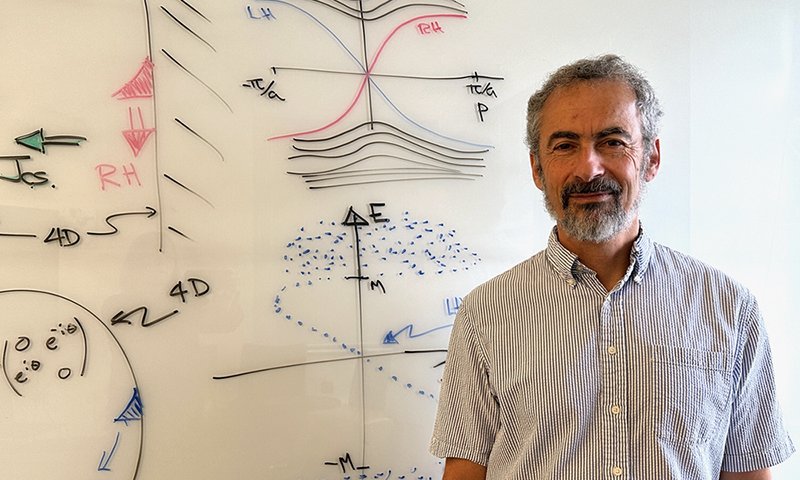Making Sense of Handedness on a Lattice
David Kaplan is on a quest to straighten out chirality, or “handedness,” in particle physics. A theorist at the University of Washington, Seattle, Kaplan has been wrestling with chirality conundrums for over 30 years. The main problem he has been working on is how to place chiral particles, such as left-handed electrons or right-handed antineutrinos, on a discrete space-time, or “lattice.” That may sound like a minor concern, but without a solution to this problem the weak interaction—and by extension the standard model of particle physics—can’t be simulated on a computer beyond low-energy approximations. Attempts to develop a lattice theory for chiral particles have run into model-dooming inconsistencies. There’s even a well-known theorem that says the whole endeavor should be impossible.
Kaplan is unfazed. He has been a pioneer in formulating chirality’s place in particle physics. One of his main contributions has been to show that some of chirality’s problems can be solved in extra dimensions. Kaplan has now taken this extra-dimension strategy further, showing that reducing the boundaries, or edges, around the extra dimensions can help keep left- and right-handed particle states from mixing [1, 2]. With further work, he believes this breakthrough could finally make the lattice “safe” for chiral particles. Physics Magazine spoke to Kaplan about the issues surrounding chirality in particle physics.
All interviews are edited for brevity and clarity.
When did you first become aware of the chirality–lattice problem in particle physics?
As an undergrad. I was checking out graduate schools, and on my visit to Princeton University, I met the theorist David Gross (who would later win the Physics Nobel Prize in 2004). I didn’t know what to say to him, so I asked him what he was working on. He told me that he was trying to put chiral fermions on a lattice. I didn’t understand what that meant at the time, but the problem stuck in my mind.
What are chiral fermions and what makes them special?
Chiral fermions are spin-1/2 particles, such as quarks and electrons. They are either left- or right-handed depending on the orientation of their spin relative to their momentum. For the most part, the handedness state of a fermion stays constant, a property called chiral symmetry. Theories run into problems when they break chiral symmetry, which happens when the model changes a fermion with a left-handed state, for example, into one with a mixture of both chiral states.
What can go wrong when a chiral fermion is put on a lattice?
It depends on what force the model considers. For the strong and electromagnetic forces, traditional lattice approaches mix the two chiral states of the fermions, making them unnaturally heavy, unless the model parameters are extremely fine tuned. This problem is more acute for the weak force, for which left- and right-handed fermions behave very differently. The theory of the weak interactions—the so-called chiral gauge theory—cannot have any mixing. And yet if theorists don’t include mixing, their calculations produce untamable infinities.
How then do theorists make predictions that account for weak interactions?
At the energies that experiments currently probe, no calculations require a fully defined chiral gauge theory. It’s more of a problem for performing computations at the high temperatures of the early Universe. But the issue goes deeper: a theory that cannot be fully simulated on a computer is fundamentally ill defined. I’m uncomfortable with our theory of the world being on such shaky ground.
What’s your strategy for getting out of this bind?
The first step that I took, about 30 years ago, was to add an extra dimension to the lattice so that it has four spatial dimensions and one time dimension [3]. We can represent these five dimensions as a long sheet with two edges. I showed that placing massive, nonchiral fermions on a sheet-like lattice causes massless chiral fermions to appear on the edges, with left-handed states on one side and right-handed states on the other side. There’s an analogy here to the edge states that are observed in materials, such as topological insulators and quantum Hall systems.
What did adding this extra dimension solve?
The extra dimension reduces state mixing by keeping left- and right-handed states spatially separate. This separation is needed for explaining important effects in quantum chromodynamics and quantum electrodynamics, which describe the strong and electromagnetic forces, respectively. However, the extra-dimension model still violated the exact chiral symmetry—the symmetry that describes weak interactions. The problem was that chiral states could still mix a tiny bit between the two edges.
And that’s what your new work addresses?
Yes. I realized that I could keep chiral symmetry by turning the sheet into a disk, so that there’s only one edge. With my colleague Srimoyee Sen from Iowa State University, I made a disk lattice populated by “Wilson fermions,” which are massive nonchiral particles. When we calculated the energy of these particles versus their angular momentum, we found clear evidence for a massless particle traveling around the circular edge in only one direction—the signature of a massless left-handed fermion with no right-handed partner to mix with.
Have the two of you studied the weak interaction on this disk lattice?
No, we still need to show that the weak-force mediators, the W and Z bosons, behave correctly on this one-edge lattice. That will take extensive computational work, but I’ve proposed a method for doing that, which I’m optimistic about.
If you—or someone else—can get a fully compliant chiral gauge theory on this one-edge lattice, what might be found?
Such a theory could be used to study nonperturbative effects in the standard model, which might turn up something unexpected. That would be fascinating, as small effects at low energy could become large effects at high-energy and thus be key to an explanation for why the Universe contains significantly more matter than antimatter. But for me what’s most fundamental about demonstrating a chiral gauge theory on a lattice is that it would provide a firm foundation for the standard model.
–Michael Schirber
Michael Schirber is a Corresponding Editor for Physics Magazine based in Lyon, France.
References
- D. B. Kaplan, “Chiral gauge theory at the boundary between topological phases,” Phys. Rev. Lett. 132, 141603 (2024).
- D. B. Kaplan and S. Sen, “Weyl fermions on a finite lattice,” Phys. Rev. Lett. 132, 141604 (2024).
- D. B. Kaplan, “A method for simulating chiral fermions on the lattice,” Phys. Lett. B 288, 342 (1992).





